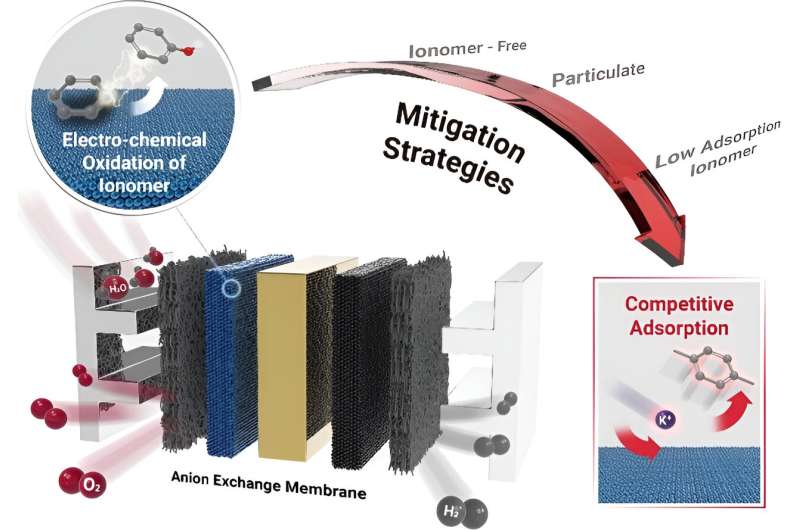
Schematic representation of the overall strategy for electrochemical oxidation prevention of ionomers. Image credit: ACS Energy Letters (2024). DOI: 10.1021/acsenergylett.4c00832
For the first time, the principle of preventing the deterioration and oxidation of ionomers in hydrogen production by anion exchange membrane water electrolyzers (AEMWEs) has been discovered. This breakthrough is expected to improve both the performance and durability of hydrogen production devices.
A research team led by Professor Seung Geol Lee in the Department of Materials Science and Engineering at UNIST has introduced a novel AEMWE technology that uses a low-cost catalyst made from non-platinum metals. By allowing potassium to adhere to the catalyst surface, this method minimizes direct contact with the ionomer, potentially reducing the cost of hydrogen production.
The results were published online in ACS Energy Letters on June 2, 2024.
In typical hydrogen production devices, the properties of the ions that enable ion transport tend to deteriorate over time, resulting in reduced hydrogen production efficiency and shortened device life.
The research team took advantage of the fact that the adsorption energy of potassium is more than three times greater than that of organic compounds. Their results show that substances such as potassium hydroxide and sodium hydroxide can significantly improve the performance and stability of the AEMWE system.
The adsorption of cationic materials on the catalyst surface reduces the direct contact between the ionomer and the catalyst. This mechanism was validated using density functional theory (DFT), which calculates the electronic structure of materials, demonstrating that oxidation of the ionomer can be prevented while maintaining hydrogen production performance.

Comparison of the adsorption energy of potassium ions (left) and benzene (right) on an IrO2(110) surface. Image credit: ACS Energy Letters (2024). DOI: 10.1021/acsenergylett.4c00832
While previous attempts to enhance performance by using aqueous potassium hydroxide and sodium hydroxide solutions with high basicity have not elucidated the underlying principles, the competitive adsorption strategy identified in this study shows promise for promoting the commercialization of low-cost catalysts.
Researcher Jihoon Lim, the first author, explained: “The competitive adsorption strategy effectively reduces the electrochemical oxidation of ionomer materials at the interface with the catalyst.”
Professor Lee said: “This study paves the way for improving the performance and stability of various energy devices, including high-performance alkaline AEMWE systems.”
Further information:
Jihoon Lim et al., The challenge of electrochemical ionomer oxidation in future anion exchange membrane water electrolyzers, ACS Energy Letters (2024). DOI: 10.1021/acsenergylett.4c00832
Provided by Ulsan National Institute of Science and Technology
Quote: New method paves the way for low-cost and highly efficient production of green hydrogen (August 13, 2024), accessed August 13, 2024 from https://phys.org/news/2024-08-method-paves-effective-high-efficiency.html
This document is subject to copyright. Except for the purposes of private study or research, no part of it may be reproduced without written permission. The contents are for information purposes only.




